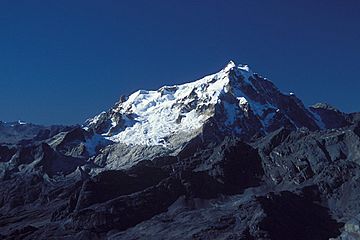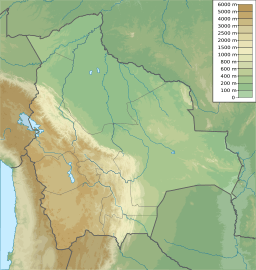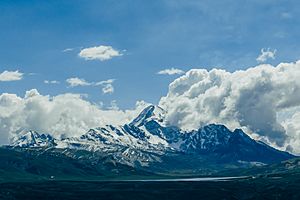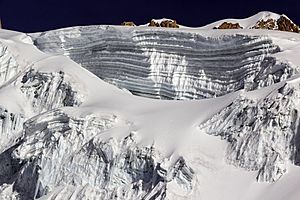Huayna Potosí facts for kids
Quick facts for kids Huayna Potosí |
|
|---|---|
 |
|
| Highest point | |
| Elevation | 6,088 m (19,974 ft) |
| Prominence | 1352 |
| Parent peak | Ancohuma |
| Geography | |
| Location | Bolivia |
| Parent range | Andes |
| Climbing | |
| First ascent | 1919 by Rudolf Dienst and O. Lhose (Germany) |
| Easiest route | straightforward glacier climb |
Huayna Potosí is a famous mountain in Bolivia. It's located near El Alto and about 25 kilometers (15 miles) north of La Paz. This mountain is part of the Cordillera Real, a mountain range in the Andes.
Huayna Potosí is the closest tall mountain to La Paz. This makes it a very popular place for climbing in Bolivia. The usual way to climb it is a fairly simple journey across a glacier. You might find some deep cracks in the ice called crevasses. The final climb to the summit (the very top) is quite steep.
However, the other side of the mountain, called the Huayna Potosí West Face, is much harder. It's the biggest rock and ice face in Bolivia, about 1000 meters (3,280 feet) high. Many difficult routes go up this challenging side.
The first people to successfully climb the normal route were Germans Rudolf Dienst and Adolf Schulze in 1919. Some climbing books say Huayna Potosí is the "easiest 6000er in the world." A "6000er" is a mountain over 6,000 meters (about 19,685 feet) tall. But this idea is often debated. The easiest path still has tricky parts, like a narrow ridge and steep ice sections.
There are actually many other 6000-meter mountains that are technically easier to climb. So, why is Huayna Potosí called easy? It's mainly because it's easy to get to from La Paz. Also, climbers don't have to gain a huge amount of elevation from the start of the climb to the top. Since La Paz is already high up (3,640 meters or 11,942 feet), climbers can get used to the altitude more easily. This process is called acclimatizing.
Mountain Climbing History
In 1877, a group of six German climbers tried to reach the top of Huayna Potosí for the first time. They didn't have the right gear or much information about the mountain. Sadly, their attempt ended in tragedy. Four climbers died high on the mountain. The other two managed to get back down but died from exhaustion near the Zongo Pass.
Twenty-one years later, in 1898, Austrian climbers tried again. They spent five days at 5,900 meters (19,357 feet) but had to turn back. Finally, in 1919, the Germans R. Dienst and O. Lhose successfully reached the south summit. They climbed the east face, which later became part of the normal climbing route we know today.
The Normal Climbing Route
The usual way to climb Huayna Potosí is a fairly direct path on the glacier. Most climbers take two days to complete this route.
First, climbers usually take a special 4x4 vehicle from El Alto. They drive for about two hours on a gravel road to a car park at 4,700 meters (15,420 feet). This spot is called Zongo Pass (16°17′15″S 68°07′47.6″W / 16.28750°S 68.129889°W). This is where a base camp is set up. There's a hut here where climbers can stay.
From the Zongo Pass hut, it's a hike of 1 to 3 hours to the high camp at 5,200 meters (17,060 feet) (16°16′32″S 68°08′16.6″W / 16.27556°S 68.137944°W). This camp is right at the edge of the snow line. Locals call this camp Campo Argentino. It has flat areas where climbers can set up their tents. There's also a refuge at the high camp where you can stay overnight for a fee. It's best to book ahead, especially during busy times.
Most climbers start their final climb to the summit very early, between midnight and 3 AM. Climbers who are fit and well-acclimatized might start later. They can reach the top in about 3 to 4 hours, but many people take twice that long. The path is usually clear, especially between the tall snow formations called penitentes. The route goes up the main glacier, sometimes along a ridge. It then curves behind the mountain.
The very last part of the climb is quite open and exposed. The summit itself is small and often has a snow overhang called a cornice. This makes the usable space at the top even smaller.
The entire climb from the high camp usually takes between 8 and 12 hours. Very experienced climbers, who are used to the altitude, might even climb the mountain directly from the Zongo Pass hut. This longer climb takes most of the day.
It's important to climb early in the morning because the sun makes the snow less stable later in the day. This also increases the risk of avalanches after 8 AM. On a clear morning, the views from the summit are amazing! Huayna Potosí is much taller than anything else nearby. You can see the Cordillera Real mountains, Lake Titicaca, the city of La Paz, and parts of the Altiplano (high plains).
Other Climbing Routes
Besides the normal route, there are many other ways to climb Huayna Potosí. Some of these routes are very technical and challenging.
- East face, French route to the south summit. This route was first climbed in 1974.
- West face, American route to the north summit. This route was first climbed in 1970.
- West face, Direct route to the north summit. This route was first climbed in 1978.
- East face, Triangulo route to the south summit. This route was first climbed in 1983.
See also
 In Spanish: Huayna Potosí para niños
In Spanish: Huayna Potosí para niños
- Milluni Peak
- Kunturiri
- Potosí mountain range





